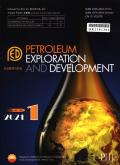Source and exploration potential of the ultra-deep Cambrian petroleum in Well XT-1, Tarim Basin, NW China
IF 8
Q1 ENERGY & FUELS
引用次数: 0
Abstract
The ultra-deep (deeper than 8 000 m) petroleum in the platform-basin zones of the Tarim Basin has been found mainly in the Lower Paleozoic reservoirs located to the east of the strike-slip fault F5 in the north depression. However, the source and exploration potential of the ultra-deep petroleum in the Cambrian on the west of F5 are still unclear. Through the analysis of lithofacies and biomarkers, it is revealed that there are at least three kinds of isochronous source rocks (SRs) in the Cambrian Newfoundland Series in Tarim Basin, which were deposited in three sedimentary environments, i.e. sulfide slope, deep-water shelf and restricted bay. In 2024, Well XT-1 in the western part of northern Tarim Basin has yielded a high production of condensate from the Cambrian. In the produced oil, entire aryl-isoprenoid alkane biomarkers were detected, but triaromatic dinosterane was absent. This finding is well consistent with the geochemical characteristics of the Newfoundland sulfidized slope SRs represented by those in wells LT-1 and QT-1, suggesting that the Newfoundland SRs are the main source of the Cambrian petroleum discovered in Well XT-1. Cambrian crude oil of Well XT-1 also presents the predominance of C29 steranes and is rich in long-chain tricyclic terpanes (up to C39), which can be the indicators for effectively distinguishing lithofacies such as siliceous mudstone and carbonate rock. Combined with the analysis of hydrocarbon accumulation in respect of conduction systems including thrust fault and strike-slip fault, it is found that the area to the west of F5 is possible to receive effective supply of hydrocarbons from the Cambrian Newfoundland SRs in Manxi hydrocarbon-generation center. This finding suggests that the area to the west of F5 will be a new target of exploration in the Cambrian ultra-deep structural-lithologic reservoirs in the Tarim Basin, in addition to the Cambrian ultra-deep platform-margin facies-controlled reservoirs in the eastern part of the basin.
塔里木盆地XT-1井超深寒武系油气来源及勘探潜力
塔里木盆地台盆带的超深层(深度超过 8 000 米)石油主要发现于位于北坳陷走向滑动断层 F5 以东的下古生界储层中。然而,F5 以西寒武系超深层石油的来源和勘探潜力尚不清楚。通过对岩性和生物标志物的分析,发现塔里木盆地寒武系纽芬兰系列至少存在三种等时源岩(SR),分别沉积于硫化斜坡、深水陆架和限制性海湾三种沉积环境中。2024 年,塔里木盆地北部西部的 XT-1 井从寒武系中产出了大量凝析油。在产出的石油中,检测到了全部芳基-异戊烯烷烃生物标志物,但没有发现三芳基二烯丙基烷烃。这一发现与以 LT-1 井和 QT-1 井为代表的纽芬兰硫化斜坡 SR 的地球化学特征十分吻合,表明纽芬兰 SR 是 XT-1 井发现的寒武纪石油的主要来源。XT-1 井的寒武纪原油还以 C29 甾烷类为主,并富含长链三环萜类(最高达 C39),可作为有效区分硅质泥岩和碳酸盐岩等岩性的指标。结合对推断断裂和走向滑动断层等传导系统的油气富集分析,发现 F5 以西地区有可能得到曼西油气生成中心寒武系纽芬兰 SR 的有效油气补给。这一发现表明,除塔里木盆地东部寒武系超深层平台-边缘面控制储层外,F5以西地区将成为塔里木盆地寒武系超深层构造-岩性储层勘探的新目标。
本文章由计算机程序翻译,如有差异,请以英文原文为准。
求助全文
约1分钟内获得全文
求助全文

 求助内容:
求助内容: 应助结果提醒方式:
应助结果提醒方式:


